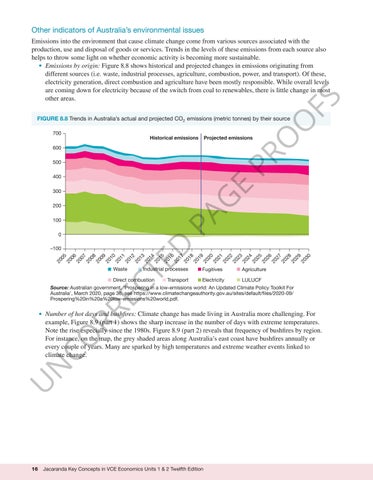“c08EconomicsAndTheEnvironment_PrintPDF” — 2022/6/6 — 17:03 — page 16 — #16
Other indicators of Australia’s environmental issues
FS
Emissions into the environment that cause climate change come from various sources associated with the production, use and disposal of goods or services. Trends in the levels of these emissions from each source also helps to throw some light on whether economic activity is becoming more sustainable. • Emissions by origin: Figure 8.8 shows historical and projected changes in emissions originating from different sources (i.e. waste, industrial processes, agriculture, combustion, power, and transport). Of these, electricity generation, direct combustion and agriculture have been mostly responsible. While overall levels are coming down for electricity because of the switch from coal to renewables, there is little change in most other areas.
Historical emissions
Projected emissions
PR
600 500
E
400
G
300
Industrial processes Transport
Agriculture
Electricity
LULUCF
30
29
20
28
20
27
20
20
26
25
20
20
24
23
20
22
20
21
20
20
20
Fugitives
CO RR EC
Direct combustion
20
18
17
20
20
20
20
20
16
15
14
13
12
TE
Waste
20
11
20
10
20
09
20
08
20
07
20
06
20
20
05
–100
D
0
20
100
19
PA
200
20
O
700
O
FIGURE 8.8 Trends in Australia’s actual and projected CO2 emissions (metric tonnes) by their source
Source: Australian government, ‘Prospering in a low-emissions world: An Updated Climate Policy Toolkit For Australia’, March 2020, page 36, see https://www.climatechangeauthority.gov.au/sites/default/files/2020-09/ Prospering%20in%20a%20low-emissions%20world.pdf.
• Number of hot days and bushfires: Climate change has made living in Australia more challenging. For
U
N
example, Figure 8.9 (part 1) shows the sharp increase in the number of days with extreme temperatures. Note the rise especially since the 1980s. Figure 8.9 (part 2) reveals that frequency of bushfires by region. For instance, on the map, the grey shaded areas along Australia’s east coast have bushfires annually or every couple of years. Many are sparked by high temperatures and extreme weather events linked to climate change.
16
Jacaranda Key Concepts in VCE Economics Units 1 & 2 Twelfth Edition





















































